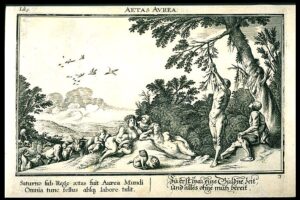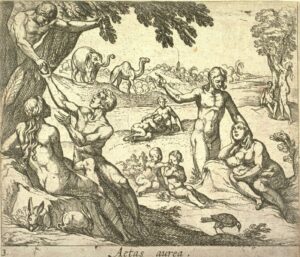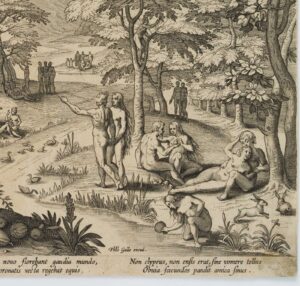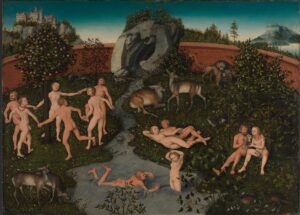In his epic work Metamorphoses, the Roman poet Ovid (43 BC – 17 AD) describes the first age of humanity as a Golden Age (Aetas Aurea). It was golden because, in this time, people lived as innocents in a state of harmony with each other and with Nature. Artists of the Renaissance were so inspired by this vision that they captured it in a series of beautiful engravings, some of which are presented below along with a translation from Ovid’s poem.

by Johann Wilhelm Baur (1703)
Metamorphoses, BOOK I, verses 89-112 1
First emerged the golden age in which faith and virtue spontaneously flourished of their own accord without authorities or laws.
Punishment and fear were absent, as were threatening words fixed in bronze, nor did people fear the stern face of the judge, but all were safe even in the absence of protection.
Not yet was the pine tree cut from its mountain to descend upon the seas so people could travel to far-away lands, and none knew any but their own shores.
Not yet did deep moats encircle cities; there were no war-trumpets, no coiled horns,
no swords and helmets. Without the use of military force, people passed their lives in sweet peace and security.
The earth herself, untouched by the hoe and unscarred by the plough, also gave freely all things from herself. People, happy to gather food that grew without work, collected arbutus fruit, mountain strawberries, cornelian cherries, blackberries clinging to the tough brambles, and acorns fallen from Jupiter’s spreading oak-tree.
Spring was eternal, and gentle winds caressed the wildflowers with warm breezes.
Soon the untilled earth even bore grains, and without needing renewal, the fields whitened with heavy ears of corn.
Rivers of milk and streams of nectar flowed, and golden honey dripped from the green holm oak.

by Antonio Tempesta (1606)
The idea of Aetas Aurea, of a perfect state that once existed but was lost never to be regained, is a powerful one. It served the polytheistic Romans in the same way the Garden of Eden serves monotheistic Judeo-Christians to this day. It reveals the cost of human imperfection while instilling a subconscious longing to find a way to its unreachable but desirable potential. As an archetype deeply embedded in our psyche, it has provided motive force to religious, political and cultural movements through the ages. The Naturist Movement itself is clearly rooted in Aetas Aurea idealism. One only has to look at the International Naturist Federation’s definition of Naturism, “a way of life in harmony with nature characterized by the practice of communal nudity with the intention of encouraging self-respect, respect for others and for the environment,” to see a direct appeal to live as in the Golden Age.

by Adriaen Collaert (1561)
These images and Ovid’s poem should resonate with Ethical Naturist readers. Not only do the scenes of non-sexual nudity in Nature resemble sunny days at a bucolic Naturist venue, but also the description of a convivial, non-judgmental community, where respectful behavior and safety are the norm despite the vulnerability of nakedness, should be familiar. We do not live in a Golden Age, but a healthy Naturist setting, like an oasis in the desert, is where one can experience something closer to Aetas Aurea than what is typical in everyday life.

by Lucas Cranach the Elder (1530)
We live in an imperfect world, and our modern society and all of us are tainted by flaws, troubles and sins. It is therefore good to have a model of a more perfect world, and it is healthy to have a tool that enlivens us to its possibilities and guides us toward it in the right direction. The Golden Age/Garden of Eden is such a model, and Ethical Naturism is such a tool. By stripping away the raiment of society and communing with others and with Nature as our authentic selves, we conform to this model and directly experience aspects of it in real life. In turn, we internalize these ideals and move closer to living them generally. It may be absurd, but one can imagine a more benevolent and harmonious age that could arise if a critical mass of the world embraced Ethical Naturism as a life philosophy.
__________________________________________________________________________
1 There are several translations of Ovid’s poem, all of which are similar but different in their word choice and phrasing. The text presented above borrows principally from the translation of Anthony S. Kline. A few edits have been made to make it more presentable in modern English to the contemporary reader.